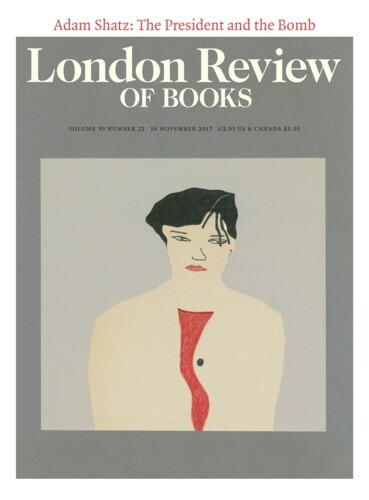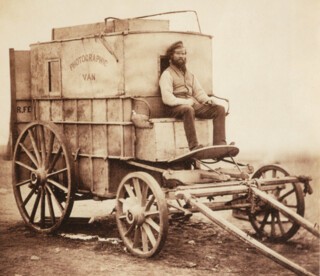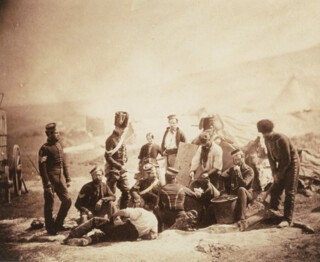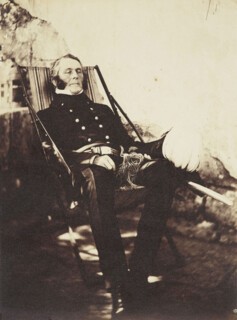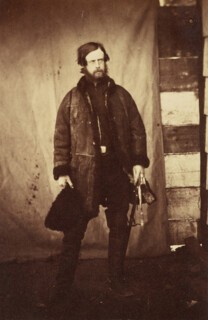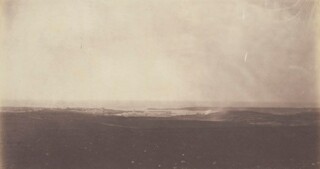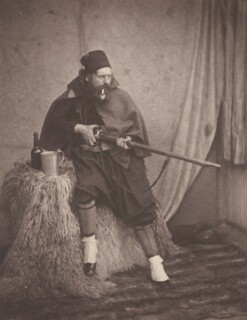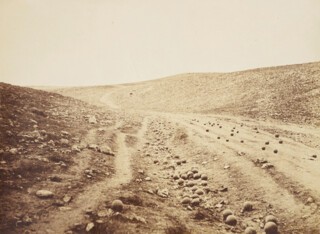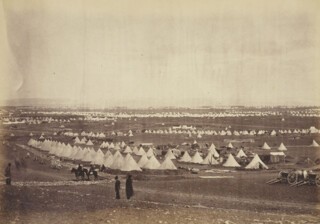There are two portraits Roger Fenton took of himself, separated by only a year, one of them in the exhibition of his photographs of the Crimean War at the Queen’s Gallery in Edinburgh (until 26 November) and the other not. The first, from 1854, seems conventional: we see a Victorian gentleman – hair parted, beard trimmed to cover only the underside of his face, leaving the strong chin to fight its own battles – seated in a chair, his arm resting on a covered table. But then we notice the strange two-tone geometry of his outfit, the way the vertical stripes on his trousers connect with the diagonals on his waistcoat, themselves repeated in the pattern of his necktie, all of it framed and contained by the black of his frock coat, offset by the white of his hands and face. We pick up, too, on the assertion: Fenton fills most of the available space, there is confidence in his composed features and concentrated gaze, in his spread legs, in the discernible bulge in his crotch. It is an advertisement for himself, for his skill at managing effects, and for the medium, then only about fifteen years old. The second self-portrait, one of the first photographs you encounter in the exhibition, is different and not. Fenton is half-seated on a table covered in a sheepskin rug and supporting a bottle of beer and a tankard; a rifle is cocked in his hands and pointed out to the right of the frame. He is wearing the uniform of a Zouave, a French infantry regiment famous for its élan and baggy red trousers; he now has a full beard, his gaze follows the line of the gun, and there’s a pipe clamped between his teeth. It is 1855, and Fenton has returned from the Crimea, where the war is still going on. The photo was taken in his London studio – a dirty sheet has been hung on the wall and a rug laid on the floor to cover the inauthenticity – but it was blandly titled A Zouave and slipped in with the nearly 350 genuine images from the war Fenton exhibited to an eager public in thirty venues over the course of the following year. There was no apparent guilt about this deception, no winking admission, at least in public: Fenton simply wanted to play a part in the story.
The camera’s capacity for transformation makes us more nervous than it did the Victorians. Fenton wasn’t a war reporter, bearing false witness; he was under orders from the printsellers Agnew and Sons, who, besides betting on a market for his photographs, had also commissioned a history painting from Thomas Barker, for whom Fenton’s work was to provide the equivalent of preparatory drawings. The purpose of his trip – Fenton arrived in March 1855 and left in June, three months before the fall of Sebastopol – wasn’t to document the unfolding war as much as it was to memorialise it. He understood that the public wanted verisimilitude of a particular kind: a truthful depiction of the men, scenes and types already familiar to them from the press reports. The Illustrated London News’s reviewer was fully aware of the staginess of Fenton’s anonymous self-portrait in uniform (‘not unmindful of creature comforts’ was his comment on the bottle of beer), but he recognised its representative value: he is ‘bent on his duty, and is cocking his formidable weapon, with a keen glance at some outlying Russian’.
The camera transformed, but not without difficulty. Fenton landed at Balaclava with five cameras in different sizes, seven hundred glass plates in three sizes, two assistants in two sizes and a battery of chemicals, packed in 36 chests. A founder of the Royal Photographic Society as well as its first honorary secretary, he was a practitioner of the wet collodion process, then only four years old. To take a photograph he coated a glass plate in collodion (cellulose nitrate mixed with alcohol and ether) and sensitised it in a silver salt solution; next he slotted it into his camera and, when he was ready, exposed it to light (exposure times were normally between seven and twenty seconds, no longer the several minutes of persistent belief). The photo had to be developed almost immediately, before the collodion dried, so a darkroom had to be close at hand. In the Crimea this took the form of a repurposed wine merchant’s van (something else Fenton brought with him): a photo of it is included in the exhibition, taken at the insistence of Fenton’s chief assistant Marcus Sparling, ‘as there was a possibility of a stop being put … to the further travels of both the vehicle and its driver’. It is a heroic image, in its way: Sparling, in the driver’s seat, seems half-proud of the absurdity of his situation. The van has a certain pride too: it looks as though it has been hammered together by Ned Kelly, and indeed it had been given a new roof and windows, as well as a retrofitted interior. It – and Fenton’s bulky equipment – made them frequent targets for enemy fire. More troublesome was the fierce heat that had succeeded an iron winter: already in March, the month of Fenton’s arrival, William Russell of the Times was cursing the hand-knitted mittens still arriving in their thousands from worried mothers. The rising temperatures interfered disastrously with the chemicals, necessitating longer exposure times, cooking the nitrate, drying out the plates as they were carried between camera and van (which soon needed to be kept within one hundred yards) and creating streaks and smears on their surfaces. By June the van was a furnace, Fenton was complaining of ‘stoppers flying out of my bottles’ and such was the glare that he couldn’t take any photographs after 10 a.m.
All considered, his achievement was immense. Fenton disapproved of the barren scenery, but his photographs are bleakly beautiful: his view of besieged Sebastopol, with its wash of grey sky over a stack of black landscape, is reminiscent of Caspar David Friedrich, the town at its centre tiny, visible only in matchstick detail. Elsewhere Crimea, under the unforgiving sun, is rendered lunar, or Martian – pitted, rubbly, leached of shade, the scrub on the cliffs like spotted mould. Fenton made an accomplished panorama of the British camp in 11 parts, splitting space and re-assembling it again in a series of crab-like movements: thousands of tents are scattered over the plain, the sky is vast and seems to touch the ground (a result of a flaw in his process, which fogs the surrounding hills), the soldiers are like toy versions of themselves, planted in their places.
There is more personality in Fenton’s group pictures, many taken in gratitude for assistance in moving his van. (Fenton was the inspiration for Beryl Bainbridge’s novel Master Georgie, but he has most in common with Pierre at the Battle of Borodino. Though a civilian, he was well-born and, armed with letters of introduction from Prince Albert, empowered to move between camps, socialising with officers and generals as he went.) Memorialising again, he cajoled a Captain Brown and his servant back into their winter dress: they squint uncomfortably into the sun from underneath fur hats. Members of the Eighth Hussars were choreographed around a cook spooning out food: a woman stands at the back, removed from the main group, with a pleased, slightly awkward smile on her face, as though she’d wandered over and been allowed to stay. Arriving at the French camp, Fenton photographed a vivandière – one of the women who provided food and drink – who has a similar look. She posed again, kneeling at the feet of a ‘wounded’ Zouave and offering a restorative glass of claret with absurd formality: the performance of another soldier, cradling his friend’s head with furrowed concern, suggests a more natural talent.
Most of these pictures were taken in the gaps between generals, Fenton’s main prey (‘each of whose portrait has to be fairly hunted down’). He photographed Lord Raglan, the British commander, sat in a doorway, presenting his hollow, soon-to-be eponymous sleeve to the camera (he’d lost an arm at Waterloo), his plumed hat a small explosion of white in his lap; Omar Pacha, his Turkish equivalent, appears in the same spot, the interleaving of black and grey in his beard finding an echo in the patterning of his uniform. There is a quite astonishing picture of General Estcourt slumped in a striped deckchair, his eyes downturned and half-closed, which upends almost every pictorial convention going in 1855. Was he enjoying the sunshine? Fed up? Others are shown sat squatly at the opening to their tents, staring into the middle distance and surrounded by their staff. It is hard not to think – again – of War and Peace (Tolstoy was serving on the Russian side). Fenton made other pictures too, mostly of men he knew or got to know. Captain Burnaby looks like a movie star. Lord Balgonie of the Grenadier Guards, on the other hand, looks wild and lonely stood in front of a filthy sheet tacked to the boards of a hut. He has the war on him in a way his superiors don’t, and you believe in him, even though he too is dressed inappropriately for the weather in a heavy sheepskin coat: he died two years later, his health destroyed.
What makes Fenton’s photographs interesting to look at, besides the obvious, is his strong awareness of the limitations of his medium, and his ability to turn these into strengths. He sought out contrasts (rendered particularly sharp by the albumen paper he generally printed them on), knowing that canvas tents would glow white in developed photographs, providing a clarifying background for the human figure and lifting landscapes. This awareness also informed his compositions. Valley of the Shadow of Death, a photograph of a ravine filled with Russian cannonballs, is built out of intersecting lines in subtly differing tones of grey: track marks wind up to the sky, the brows and slopes of the hills seem to interlock, meeting and continuing on from each other. The balls in the foreground are silvery, blending with the rocky ground; those further out are darker, defined by deadly intent. But what most struck me at the show – it doesn’t at all translate onto the printed page, with its flattening effect, so you will have to take my word for it – was the camera’s brilliance at representing texture, clothes especially. As in painting, the effect is achieved through exaggerated attention: its contrasts of light and dark accentuate the folds in trousers, the ripple of silk, the bristle of tweed. Most dazzling and unexpected are Colonel Adye’s boots, which gleam like wet ink: in Fenton’s portrait the light pours slickly down the leather, welling in its creases.
The critical response to Fenton’s photographs, when they were first exhibited, was positive, and the popular response – judging by the number of visitors (two million, by one, surely excitable, estimate) – even more so. And yet they were prohibitively expensive, at £63 for the full set (even the cheapest image cost 10 shillings and sixpence), and sales were disappointing. Barker delivered his history painting, The Allied Generals with the Officers of Their Respective Staffs before Sebastopol (1856), based largely on Fenton’s photographs and not a patch on any of them. Helpfully, the otherwise unobtrusive curators have spotlighted Barker’s various borrowings: almost every figure he gathered on the plateau is copied from a study made by Fenton, usually in the same pose and from the same angle, so that the majority exist in strange isolate proximity, heads twisted away from each other like cut-outs stuck down on a ready-made backdrop. The Zouave Fenton photographed being tended by a vivandière was also imported wholesale, but Britished, put into a kilt.
The show ends with some of the things Fenton left out. Sebastopol after the siege was photographed by James Robertson, who revealed the destruction to be total and uninteresting, as wreckage must be to those who don’t know what was there before. More striking are the photographs of wounded veterans commissioned by Queen Victoria: glimpsed only in reproduction is Joseph Cundall and Robert Howlett’s stark portrayal of three amputees, two double and one single, sat together on a bed, taking up not enough space between them. Victoria commissioned this quiet image and many others like them for her personal collection (they deserve to be better known), providing a visual index for encounters she’d had with individual soldiers at military hospitals and receptions. These were necessarily public occasions too, emblematic of the royal family’s commitment to the army (and, by extension, the nation) in extremis. The final exhibit is John Gilbert’s huge watercolour, The Queen Inspecting Wounded Coldstream Guardsmen in the Hall of Buckingham Palace (1856), at first sight a schmaltzy and fairly undistinguished representation of this unwritten contract. It’s not clear that this isn’t how the curators see it. The queen is placed on the right of the picture, together with Albert, four of her children and her cousin the Duke of Cambridge (invalided home from the war). On the left are the guards, swaddled in their heavy regulation coats and massed darkly into a pyramid which pushes from the back of the hall to form a point in a man with a sling, who has stepped forward to salute his sovereign with his free hand. Several of the men have sticks and have had to be seated, two have bandaged heads, all of them look grim, but also sullen, accusatory, pale, with streaks of shadow under their eyes. Buried in the crowd of faces, towards the middle, is an alarming detail: a man with wide, frantic eyes, his head snapped back as if in a fit. There is a date in the title: 22 February 1855. These are the men who had survived the harrowing winter of 1854, when what Lytton Strachey described as ‘the endless ramifications of administrative incapacity’ left 13,000 men on the sick lists and the nation scandalised. The queen might be blameless, but the government was not. Gilbert’s painting isn’t irenic, it’s an indictment. Like Fenton, he has made himself part of the story.
Send Letters To:
The Editor
London Review of Books,
28 Little Russell Street
London, WC1A 2HN
letters@lrb.co.uk
Please include name, address, and a telephone number.
